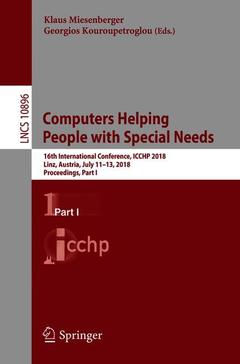The two-volume set LNCS 10896 and 10897 constitutes the refereed proceedings of the 16th International Conference on Computers Helping People with Special Needs, ICCHP 2018, held in Linz, Austria, in July
2018.
The 101 revised full papers and 78 short papers presented were carefully reviewed and selected from 356 submissions. The papers are organized in the following topical sections: Web accessibility in the connected world; accessibility and usability of mobile platforms for people with disabilities and elderly persons: design, development and engineering; accessible system/information/document design; accessible e-learning - e-learning for accessibility/AT; personalized access to TV, film, theatre, and music; digital games accessibility; accessibility and usability of self-service terminals, technologies and systems; universal learning design; motor and mobility disabilities: AT, HCI, care; empowerment of people with cognitive disabilities using digital technologies; augmented and alternative communication (AAC), supported speech; Art Karshmer lectures in access to mathematics, science and engineering; environmental sensing technologies for visual impairment; 3D printing in the domain of assistive technologies (AT) and do it yourselves (DIY) AT; tactile graphics and models for blind people and recognition of shapes by touch; access to artworks and its mediation by and for visually impaired people; digital navigation for people with visual impairments; low vision and blindness: human computer interaction; future perspectives for aging well: AAL tools, products, devices; mobile healthcare and m-health apps for people with disabilities; and service and information provision.




